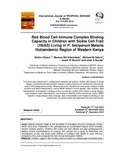Red Blood Cell Immune Complex Binding Capacity in Children with Sickle Cell Trait (HbAS) Living in P. falciparum Malaria Holoendemic Region of Western

View/
Date
2012Author
Otieno, Walter
Estambale, Benson
Odera, Michael M
Aluoch, Joash R
Stoute, José A
Type
ArticleLanguage
enMetadata
Show full item recordAbstract
Aims: Malaria infection leads to the formation of circulating immune complexes (CICs)
which have been implicated in the pathogenesis of complicated malaria which includes
severe malarial anemia. Children with sickle cell trait (HbAS) are less predisposed to
getting severe manifestations of malaria. We carried out a study to determine the
competence of the red blood cells (RBCs) of children with HbAS to bind immune
complexes (ICs) and compared this with normal hemoglobin (HbAA).
Methods: Children (aged 0-192 months) were enrolled in a nested case controlled study conducted in Kombewa Division, Kisumu West District, Kenya. Based on hemoglobin
(Hb) type, children were stratified into those with HbAS (n=47) and HbAA (n=69). The 47
HbAS individuals were matched to 69 HbAA of similar age. The children were further
categorized into three cohorts (0-12, 13-48 and 49-192 months). Immune complex
binding capacity (ICBC) was quantified using a FACScan flow cytometer under normal
and reduced oxygen saturation.
Results: The mean immune complex binding capacity for the HbAS cells was
significantly higher than that of HbAA cells (P=0.0191) under normal oxygen saturation or
under reduced oxygen saturation (P=0.0050). When a matching variable (UNIANOVA)
was done to control for age, gender, the presence or absence of malaria parasitaemia,
the binding capacity was again significantly higher for the HbAS than for HbAA under
normal oxygen saturation (P=0.025) and under reduced oxygen saturation (P=0.003).
The binding capacity was lowest in the 7-12 months age group for both HbAS and HbAA;
however, the overall picture showed that HbAS individuals had higher immune complex
binding capacity than HbAA in all the age cohorts.
Conclusion: These results demonstrate that the protection afforded by HbAS against
severe manifestations of malaria may be partly due to higher immune complex binding
capacity of the HbAS compared to the HbAA cells. This high binding capacity may lead to
the mopping up of ICs formed during malaria attacks and therefore protect these cells
from deposition and subsequent destruction.
Citation
International Journal of TROPICAL DISEASE & Health 2(4): 272-282, 2012Publisher
University of Nairobi Institute of Tropical and Infectious Diseases (UNITID), Kenya. US Army Medical Research Unit, Kenya Medical Research Institute, Kisumu, Kenya. Maseno University School of Medicine, Kisumu, Kenya Department of Medicine, Penn State University College of Medicine, Pennsylvania, USA.
Collections
- Faculty of Health Sciences (FHS) [10378]
